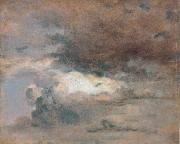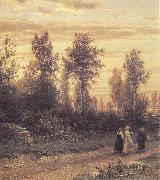
|
Samuel Palmer
|
|||
|
|
|||
| 1805-1881 British Samuel Palmer Galleries English painter, draughtsman and etcher. Palmer was a key figure of English Romantic painting who represented, at least in his early work, its pastoral, intuitive and nostalgic aspects at their most intense. He is widely described as a visionary and linked with his friend and mentor William Blake, though he stood at an almost opposite extreme in his commitment to landscape and his innocent approach to its imagery. He had none of Blake irony or complexity and was inspired by a passionate love of nature that found its philosophical dimension in unquestioning Neo-Platonism. | |||
|
|
|||
|
Evening new2/Samuel Palmer-668574.jpg Painting ID:: 26368 |
mk49 1821 Brown ink and brown wash | ||
|
|
|||
|
John Constable
|
|||
|
|
|||
| 1776-1837 British John Constable Locations 1837). English painter and draughtsman. His range and aspirations were less extensive than those of his contemporary J. M. W. Turner, but these two artists have traditionally been linked as the giants of early 19th-century British landscape painting and isolated from the many other artists practising landscape at a time when it was unprecedentedly popular. Constable has often been defined as the great naturalist and deliberately presented himself thus in his correspondence, although his stylistic variety indicates an instability in his perception of what constituted nature. He has also been characterized as having painted only the places he knew intimately, which other artists tended to pass by. While the exclusivity of Constable approach is indisputable, his concern with local scenery was not unique, being shared by the contemporary Norwich artists. By beginning to sketch in oil from nature seriously in 1808, he also conformed with the practice of artists such as Thomas Christopher Hofland (1777-1843), William Alfred Delamotte, Turner and, particularly, the pupils of John Linnell. Turner shared his commitment to establishing landscape as the equal of history painting, despite widespread disbelief in this notion. Nevertheless, although Constable was less singular than he might have liked people to believe, his single-mindedness in portraying so limited a range of sites was unique, and the brilliance of his oil sketching unprecedented, while none of his contemporaries was producing pictures resembling The Haywain (1821; London, N.G.) or the Leaping Horse (1825; London, RA). This very singularity was characteristic of British artists at a time when members of most occupations were stressing their individuality in the context of a rapidly developing capitalist economy | |||
|
|
|||
|
Evening new9/John Constable-372242.jpg Painting ID:: 32988 |
mk82 31 Auguse 1822 | ||
|
|
|||
|
Ivan Shishkin
|
|||
|
|
|||
| Russian Painter, 1832-1898 was a Russian landscape painter closely associated with the Peredvizhniki movement. Shishkin was born in the town of Elabuga of Vyatka Governorate (today Republic of Tatarstan), and graduated from the Kazan gymnasium. He then studied at the Moscow School of Painting, Sculpture and Architecture for 4 years, then attended the Saint Petersburg Imperial Academy of Arts from 1856 to 1860, graduating with the highest honors and a gold medal. He received the Imperial scholarship for his further studies in Europe. Five years later Shishkin became a member of the Imperial Academy in St. Petersburg and was professor of painting from 1873 to 1898. At the same time, Shishkin headed the landscape painting class at the Higher Art School in St. Petersburg. For some time, Shishkin lived and worked in Switzerland and Germany on scholarship from the St. Petersburg Imperial Academy of Arts. On his return to Saint Petersburg, he became a member of the Circle of the Itinerants and of the Society of Russian Watercolorists. He also took part in exhibitions at the Academy of Arts, | |||
|
|
|||
|
Evening new10/Ivan Shishkin-282548.jpg Painting ID:: 35090 |
mk100 1871 Oil on canvas 71x44cm | ||
|
|
|||
|
Caspar David Friedrich
|
|||
|
|
|||
| 1774-1840 Caspar David Friedrich Locations German painter, studied art at Copenhagen, and in 1798 settled in Dresden. Friedrich painted chiefly landscapes and seascapes, with and without figures, architectural pictures, including a few of Dresden, and some religious subjects. Religious feeling and symbolism permeate his œuvre, of which the seascape with figures, Die Lebensstufen, is a characteristic example. He possessed considerable power to convey mood in landscape. Almost forgotten in the 19th c. and early 20th c., interest in his work increased considerably in the mid-20th c. He is hardly represented in Britain, but an exhibition of 112 of his pictures at the Tate Gallery in 1972 attracted much attention. F. G. Kersting was a friend of Friedrich. | |||
|
|
|||
|
Evening new16/Caspar David Friedrich-582238.jpg Painting ID:: 44173 |
c. 1824 Oil on cardboard, 20 x 27,5 cm | ||
|
|
|||
|
Henri Edmond Cross
|
|||
|
|
|||
| 1856-1910 French Henri Edmond Cross Locations French painter and printmaker. The only surviving child of Alcide Delacroix, a French adventurer and failed businessman, and the British-born Fanny Woollett, he was encouraged as a youth to develop his artistic talent by his father cousin, Dr Auguste Soins. He enrolled in 1878 at the Ecoles Academiques de Dessin et d Architecture in Lille, where he remained for three years under the guidance of Alphonse Colas (1818-87). He then moved to Paris and studied with Emile Dupont-Zipcy (1822-65), also from Douai, whom he listed as his teacher when exhibiting at Salons of the early 1880s. His few extant works from this period are Realist portraits and still-lifes, painted with a heavy touch and sombre palette (example in Douai, Mus. Mun.). | |||
|
|
|||
|
evening new23/Henri Edmond Cross-947997.jpg Painting ID:: 71180 |
mk290 air 1893-94 oil on canvas 45x65 in musee d orsay paris | ||
|
|
|||
|
Also Buy::. For Following Paintings / Artists / Products, Please Use Our Search Online: |












